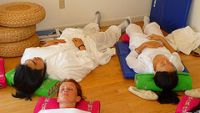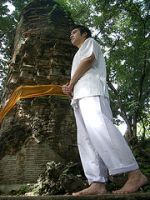Meditation – Ideal Relaxation Technique

Used commonly as a relaxation technique, meditation in its varying forms is the practice of focusing the mind. It is used in religious practices, complimentary therapies and spirituality with different traditions and different treatments using a variety of techniques and physical positions. However, although extremely varied in approach, the fundamentals of meditation are accessible to everyone. Try these basic meditation techniques at home to enjoy a few moments of stillness and calm. Ensure that the room you use to meditate in is free of noise and distractions, is warm and comfortable and that you won’t be disturbed. It can be a good idea to focus on something relaxing and calming in your mind. This will help you to forget about your daily worries and make you more able to relax. Relaxation is commonly associated with having nothing on our mind that we feel we need to do. We say we relax in front of the television, in the garden or in the local coffee shop. These forms of relaxation certainly are a welcome break from the daily grind. But while doing these things, our spine might be twisted, hips turned awkwardly or arms and legs under pressure from each other. Our mind might start wandering, turning our worries and concerns, or simply day dreaming. We might be drinking alcohol, taking stimulants or eating junk food. Relaxation through meditation is different. In meditation we turn our attention to our whole being, using the power of our mind to relax our whole being. Breathing and movement are crucial elements of meditation, particularly breathing. A lot of meditation is carried out still, but slow deliberate movements can be used very effectively to focus the mind.

Basic Meditation Technique Using Breathing:
Lie comfortably on a blanket or rug on the floor or on a bed and enjoy the stillness for a few seconds, trying to let your thoughts calm. Allow your breathing to become deep and regular and focus on the weight of your body on the floor. In your mind, name your body parts, beginning at your toes and working all the way through to the head, focusing on any areas of tension you feel. For a count of five allow your body to tense, inhale a deep breath, and relax your body while pushing out the air you have just taken in. By focusing on your breathing you may find that it is easier to clear your mind of other thoughts. Breathing in through the nose and out through the mouth, ensure you take deep breaths, holding the air inside your lungs for a couple of seconds before you exhale. Keep focusing on your breathing, if your mind starts to wander, don’t worry, just refocus on the breath sounds and get back in rhythm. Give yourself several minutes and then bring your attention back to where you are.

Basic Meditation Technique Using Movement:
Ensuring that you have sufficient space to move around freely, stand with your palms by your waist, closing your eyes and allow your body to move in whatever way feels natural. The movements should be slow and simple. Concentrate on keeping every part of the body losse, but don’t overthink what you are doing. Allowing natural and free movements is how this exercise works best. You may find that moving one part of your body at a time works best to begin with. Try to sense your muscles moving, and focus in on areas that feel better for movement, To end this exercise, concentrate on your arms and hands, with your palms facing upwards. Allow them to move freely for a moment or two thinking only about the movements you are making, and end the exercise by shaking out your limbs.